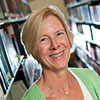This article is more than 5 years old.

Today the conference went until noon but you could see that many people had already headed for the airport. However, there was still a good deal of information conveyed to those of us who stuck it out (also door prizes at the final general session, must be present to win – no, I didn’t….)
Things started out early with several people presenting their projects via a poster session. Subjects ranged from adventures in digitization to turning technophobes into technophiles. As you might expect, the booths with the most action were the ones that were giving away candy!
There was only one set of concurrent sessions today, so I split my time between two of them. The first one reported on a locally developed Workflow Management System, designed to ingest metadata and digital objects into Fedora, Rutgers’ digital object repository. The speaker was Mary Beth Weber who leads the metadata work group for this IMLS grant-funded project that is charged with building a NJ statewide repository. The system will soon be open source (by 2008) and was of interest to me because it is the type of system that would be useful in Digital Forsyth. As we are doing through an Access database developed by Erik and Kevin, this system tracks the life of a digital objects from their birth (at scanning) to their ingestion into a digital management system. Whether it may have some future value to us, I can’t tell at this point, but we will keep an eye on how it progresses.
I caught the second half of a session by David Lindahl and Nancy Fried Foster from University of Rochester. She reported on user-centered research conducted at their institution. Some of the results have recently been published in an ACRL monograph titled: Studying Students: The Undergraduate Research Project at the University of Rochester. Since I didn’t arrive until after her portion, I’m glad I’ll be able to see the results that are reported in the book. Lindahl talked about a grant-funded project to build The Extensible Catalog, an open source system that will be used as the front end to a library’s ILS (user interface).
The final closing session was given by Jeremy Frumkin from Oregon State University who talked about “In Our Cages with Golden Bars”. The overall theme was how we can think differently about how we pursue what we do with technology in libraries. We are often limited by our own traditions, expertise and experiences. He suggests that librarians can step outside (of their golden bar cages) without throwing away the things that libraries have always done. He used the same themes that we had heard throughout the weekend (all probably at every library conference any of us have attended in the past year): what has to be done to meet our next generation of users, still providing traditional services but remixing them in a way that will insure that libraries remain sticky (from www.2020systems.com: “A term used to describe a web site on which visitors stay at for longer than normal. This is often due to the variety of content and features offered to the visitor which prevents them from needing to go elsewhere for more information”). He talking specifically about a project his library is working on: LibraryFind. It’s a metasearch tool, one that they have prominently displayed from their website. He also presented two other main themes: He believes that our business model has to change to one where libraries and vendors work together to find a mutual advantage that works for both while giving users what they want/need. He also believes that we (as in libraries as a group) need to find a way to brand our services/product so that users can find consistency from one library to the next. He likened this to the fact that pre-automation, a library patron could learn to use the card catalog at one library and be assured that this knowledge was transferable at any other library that he might visit. That certainly isn’t the case today and it leaves users without a sense of the collective identity of “library.” The presentation combined some popular user-centered themes and future thinking along with a dab of practical applications. It was a good solid end to the conference.
I’m sitting in the Denver airport now, waiting to head home in about an hour. It’s been a packed 3 days that, overall, have been well worth coping with air travel these days (We’ll see if I still think that tomorrow morning).
